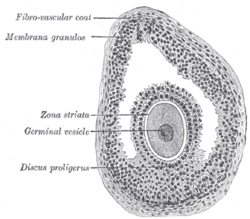- Cumulus oophorus
-
Cumulus oophorus 
Section of vesicular ovarian follicle of cat. X 50. (Discus proligerus labeled at lower left.) Gray's subject #266 1256 The cumulus oophorus (Latin cumulus=heap, Greek oo=egg + phorus=carrying), also called discus proligerus, is a cluster of cells (called cumulus cells) that surround the oocyte both in the ovarian follicle and after ovulation. In the antral follicle, it may be regarded as an extension of the membrana granulosa.
This layer of cells must be penetrated by the spermatocyte in order for fertilization to occur.
Contents
Functions
Functions of the cumulus oophorus include coordination of follicular development and oocyte maturation.[1] Mechanisms of the latter include stimulation of amino acid transport and sterol biosynthesis and regulation of oocyte gene transcription.[1]
It also provides energy substrates for oocyte meiotic resumption and promotes glycolysis.[1]
In addition, it provides protection for the oocyte.[1]
Gene expression profiling
As a part of the process of in vitro fertilization, gene expression profiling of cumulus cells can be performed to estimate oocyte quality and the efficiency of an ovarian hyperstimulation protocol, and may indirectly predict oocyte aneuploidy, embryo development and pregnancy outcomes.[1] Increased knowledge in these aspects is useful in, for example, embryo selection.[1]
In gene expression profiling of cumulus cells, genes where increased expression is correlated with higher oocyte competence or better pregnancy outcomes include: HAS2, GREM1 and PTGS2.[1]
In contrast, genes where increased expression is correlated with lower oocyte competence or worse pregnancy outcomes include: BDNF, CCND2, CXCR4, GPX3, HSPB1, DVL3, DHCR7, CTNND1, TRIM28, STAR, AREG, CX43, PTGS2, SCD1 and SCD5.[1]
References
- ^ a b c d e f g h Fauser, B. C. J. M.; Diedrich, K.; Bouchard, P.; Dominguez, F.; Matzuk, M.; Franks, S.; Hamamah, S.; Simon, C. et al. (2011). "Contemporary genetic technologies and female reproduction". Human Reproduction Update 17 (6): 829–847. doi:10.1093/humupd/dmr033. PMC 3191938. PMID 21896560. http://www.pubmedcentral.nih.gov/articlerender.fcgi?tool=pmcentrez&artid=3191938.
External links
- Organology at UC Davis Reproductive/mammal/ovary5/ovary3 - "Mammal, bovine ovary (LM, Medium)"
- Anatomy at MUN repro/reproov
- Swiss embryology (from UL, UB, and UF) dbefruchtung/objectbefru01
- UIUC Histology Subject 366
- Histology at BU 18404loa - "Female Reproductive System: ovary, cumulus oophorus"
This article was originally based on an entry from a public domain edition of Gray's Anatomy. As such, some of the information contained within it may be outdated.
Female reproductive system (TA A09.1–2, TH H3.07.01, GA 11.1254) Internal Adnexacorpus (hemorrhagicum, luteum, albicans) · Theca of follicle (externa, interna) · Follicular antrum (Follicular fluid) · Corona radiata · Zona pellucida · Membrana granulosa · Perivitelline spaceOtherProper of ovary · Suspensory of ovarycorpus/body (Uterine cavity, Fundus) · cervix/neck (External orifice, Canal of the cervix, Internal orifice, Supravaginal portion of cervix, Vaginal portion of cervix, Cervical ectropion) · Uterine hornsGeneralExternal Mons pubis · Labia majora (Anterior commissure, Posterior commissure) · Pudendal cleft · Labia minora (Frenulum of labia minora, Frenulum of clitoris) · Vulval vestibule · Interlabial sulci · Bulb of vestibule · Vaginal orifice
vestibular glands/ducts (Bartholin's glands/Bartholin's ducts, Skene's glands/Skene's ducts)Other Categories:- Female reproductive system
- Genitourinary system stubs
Wikimedia Foundation. 2010.
